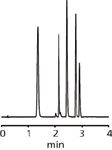New Generation Monolithic Silica Columns for Fast, High Resolution Drug Separations without High Pressures
Using a novel new-design monolithic silica column (Chromolith? HighResolution RP-18e), fast, high resolution separations were achieved for various drug mixtures without the high pressures characteristic of modern particulate technology.
Karin Cabrera and Egidijus Machtejevas, Merck Millipore
Using a novel new-design monolithic silica column (Chromolith® HighResolution RP-18e), fast, high resolution separations were achieved for various drug mixtures without the high pressures characteristic of modern particulate technology.
Monolithic silica technology has evolved as a significant development in fast HPLC analysis over the last decade. As the true alternative to conventional particle-packed column technology, the columns are made of a continuous single piece of high purity porous silica. A sol-gel synthesis process is used, leading to single-particle rod columns, which possess a bimodal pore structure with macro- (flow path) and meso- (active site) pores in the 1 μm and 140 Angstrom range. High performance results from the permeability efficiency of the fixed flow pathways in the highly-controlled porosity of the synthesized rigid silica skeleton. The resulting very low operating back pressures compared to closely-packed spherical particles allow for more flexible flow rates and solvent choice and enable high throughput analysis without loss of separation efficiency and peak capacity. Monolithic silica columns are increasingly being used for quality control of drugs. Easy and cost-effective method transfer offers it great advantages over other trends toward fast HPLC analysis. Flow programming with monolithic columns provides additional reduction of analysis time. Since there is no particle bed to disturb, pressure shocks do not affect its performance or lifetime. The possibility for direct injection of biological fluids without pretreatment has made it more applicable for bioanalysis (1). To date, hundreds of papers have been published describing the use of monolithic columns in various analytical fields which include routine drug analysis and QC, food and environmental analysis, natural products analysis and bioanalysis (2).

Figure 1: 1 μL injection of seven beta-blockers (atenolol 100 μg/mL, pindolol 300 μg/mL, metoprolol 155 μg/mL, bisoprolol 100 μg/mL, labetalol 200 μg/mL, propanolol 20 μg/mL, alprenolol 150 μg/mL) in mobile phase on a 100 à 4.6 mm Chromolith® HighResolution RP-18e column using a 23:77 (v/v) acetonitrile and 20 mM potassium dihydrophosphate buffer (pH adjusted to 2.5 with phosphoric acid) mobile phase at 2 mL/min flow rate. UV detection at 230 nm, column temperature 25 °C.
In this application note a separation of drug substances is presented. Seven beta-blockers are baseline separated in 4 min at 2 mL/min flow rate with just 76 bar back pressure (Figure 1). Even short columns have sufficient resolution to separate five drugs in < 3 min (Figure 2). Both separations possess high efficiency and high peak symmetry. Both of these applications can easily be adapted to MS detection, by simply adding a post-column flow splitter to a MS detector for further characterization of the API.

Figure 2: Separation of five drugs on Chromolith® HighResolution RP-18e 25-4.6 mm column. Chromatographic conditions: 2 μL injection of 100 ppm of actaminophen (98 μg/mL), quinine (152 μg/mL), salicylic acid (140 μg/mL), diltiazem (81.2 μg/mL), verapamil (98.4 μg/mL) in mobile phase; linear acetonitrile gradient from 1% to 60% water with 0.1% TFA in 1.8 min; flow rate 2 mL/min; column back pressure 31 bar; UV detection at 230 nm, column temperature 25 °C.
Conclusions
Separation of drugs is easily achieved on a newly designed monolithic silica Chromolith® HighResolution columns. This application note illustrates that ultra-high efficiencies could be reached without ultra-high pressures.
References
(1) E. Machtejevas and K.K. Unger, in Proteomics Sample Preparation, Sample preparation for HPLC – based proteome analysis, Jörg von Hagen, Ed. (Wiley-VCH, Weinheim, Germany, 2008), pp. 245–264.
(2) M. Taha, A. Abed, and S. El Deeb, in Monolithic silicas in separation science, Quality control of drugs, K.K. Unger, N. Tanaka, and E. Machtejevas, Eds. (Wiley-VCH, Weinheim, Germany, 2011), pp. 189–206.
Merck KGaA
Frankfurter Str. 250
D 64293 Darmstadt, Germany

SEC-MALS of Antibody Therapeutics—A Robust Method for In-Depth Sample Characterization
June 1st 2022Monoclonal antibodies (mAbs) are effective therapeutics for cancers, auto-immune diseases, viral infections, and other diseases. Recent developments in antibody therapeutics aim to add more specific binding regions (bi- and multi-specificity) to increase their effectiveness and/or to downsize the molecule to the specific binding regions (for example, scFv or Fab fragment) to achieve better penetration of the tissue. As the molecule gets more complex, the possible high and low molecular weight (H/LMW) impurities become more complex, too. In order to accurately analyze the various species, more advanced detection than ultraviolet (UV) is required to characterize a mAb sample.














